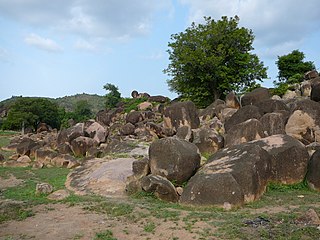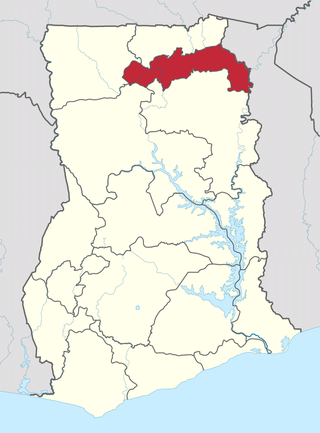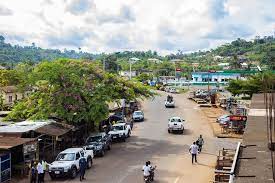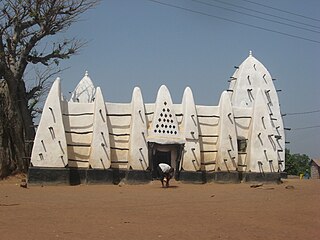
Tamale is the capital city of the Northern Region of Ghana. It is Ghana's third largest city, with a population of 371,351 people. The city has been ranked as the fastest-growing city in West Africa. Tamale is located in the Kingdom of Dagbon, Ghana's oldest Kingdom. Major ethnic groups who resided in Tamale are Dagomba, Gonja, Mamprusi, Akan, and Dagaaba.

The Upper East Region is located in northern part of Ghana and it is the third smallest of the 16 administrative regions in Ghana. It occupies a total land surface of 8,842 square kilometers or 2.7% of the total land area of Ghana. The regional capital is Bolgatanga, which is sometimes referred to as Bolga. Other major towns in the region include Navrongo, Paga, Sandema, Bawku, and Zebilla, Tempane, Pusiga, Garu, Pwalugu, Widana

Aflao is a border town in the Ketu South District in the Volta Region of Ghana on the border with Togo. Aflao is the twenty-eighth most populous settlement in Ghana, in terms of population, with a population of 66,546 people. The current municipal chief of Aflao is Hon. Maxwell Koffie Lugudor.

East Mamprusi Municipal Assembly is one of the six districts in North East Region, Ghana. Originally created as an ordinary district assembly in 1988 when it was known as East Mamprusi District, which was created from the former Mamprusi District Council, until the eastern part of the district was split off by a decree of president John Agyekum Kufuor on 19 August 2004 to create Bunkpurugu-Yunyoo District; thus the remaining part has been retained as East Mamprusi District. However on 15 March 2018, it was elevated to municipal district assembly status to become East Mamprusi Municipal District. The municipality is located in the eastern part of North East Region and has Gambaga as its capital town.

Kassena-Nankana Municipal is one of the fifteen districts in Upper East Region, Ghana. Originally it was formerly part of the then-larger Kassena-Nankana District in 1988, until the western part of the district was split off to create Kassena-Nankana West District on 29 February 2008; thus the remaining part has been renamed as Kassena-Nankana East District, which it was later elevated to municipal assembly status on 28 June 2012 to become Kassena-Nankana Municipal District. The municipality is located in the western part of Upper East Region and has Navrongo as its capital town.

West Mamprusi Municipal Assembly is one of the six districts in North East Region, Ghana. Originally created as an ordinary district assembly in 1988 when it was known as West Mamprusi District, which was created from the former Mamprusi District Council, until the western part of the district was split off on 28 June 2012 to create Mamprugu-Moagduri District; thus the remaining part has been retained as West Mamprusi District. However, on 15 March 2018, it was elevated to municipal district assembly status to become West Mamprusi Municipal District. The municipality is located in the western part of North East Region and has Walewale as its capital town. Other settlements within the municipal assembly include Wulugu.

South Dayi District is one of the eighteen districts in Volta Region, Ghana. Originally it was formerly part of the then-larger Kpando District on 10 March 1989, until the southern part of the district was split off by a decree of president John Agyekum Kufuor on 19 August 2004 to create South Dayi District; thus the remaining part has been retained as Kpando District. The district assembly is located in the western part of Volta Region and has Kpeve as its capital town.

Builsa North is one of the constituencies represented in the Parliament of Ghana. It elects one Member of Parliament (MP) by the first past the post system of election. Builsa North is located in the Builsa district of the Upper East Region of Ghana.

Kassena-Nankana West District is one of the fifteen districts in Upper East Region, Ghana. Originally, it was formerly part of the then-larger Kassena-Nankana District in 1988, until the western part of the district was split off to create Kassena-Nankana West District on 29 February 2008; thus the remaining part has been renamed as Kassena-Nankana East District. The district assembly is located in the western part of Upper East Region and has Paga as its capital town.

Walewale is one of the constituencies represented in the Parliament of Ghana. It elects one Member of Parliament (MP) by the [first past the post] / Simple Majority] system of election. Walewale is located in the West Mamprusi Municipal of the North East Region of Ghana. It is the Municipal capital of West Mamprusi Municipal Assembly. The constituency was formerly called the West Mamprusi Constituency.
Sandema is the capital town of Builsa North District, a district in the Upper East Region of Ghana.

Walewale is a town and the capital of Mamprusi West Municipal in the North East Region of Ghana. The West Mamprusi Municipal is one of the 261 Metropolitan, Municipal, and District Assemblies (MMDAs) in Ghana, and forms part of the 6 MMDAs in the North East Region. The West Mamprusi Municipality is one of 45 new districts created in 1988 under the Government of Ghana’s decentralization and was later replaced with LI 2061 in 2012. With its administrative capital as Walewale.

Sefwi Wiawso is a town in the Sefwi-Wiawso Municipal District in the Western North Region of Ghana. It doubles as the capital of Sefwi-Wiawso Municipal District and Western North Region. Wiawso serves as the traditional seat for the Omanhene of Sefwi-Wiawso traditional area. The settlement of Wiawso began on hilltop with Sefwi-Dwenase settlement occupying the lowlands. Overtime, Wiawso and Sefwi-Dwenase have conurbated with almost all the financial institutions, governmental agency-offices, lorry terminals and the main market all located in Sefwi Dwenase. Wiawso is known for producing timber, cocoa and cashew. One of Ghana's 261 Metropolitan, Municipal and District Assemblies (MMDAs), Sefwi Wiawso Municipal is a member of the 22 MMDAs in the Western North Region. Legislative Instrument (L.I) 1386, which was passed on November 23, 1988, formed the Municipality and designated Wiawso as its official capital. Based on the 2021 population and residential census, there are 151,220 people living in the Municipality, including 75,905 men and 75,315 women.
Builsa is a town in the Builsa District of the Upper East Region of Ghana. The capital of Bulsa North District is Sandema, of Bulsa South District Fumbisi; other villages/towns are Wiaga, Fumbisi, Kanjaga, Gbedema, Siniensi, Kadema and Chuchuliga.

Builsa South District is one of the fifteen districts in Upper East Region, Ghana. Originally it was formerly part of the then-larger Builsa District in 1988, until the southern part of the district was split off to create Builsa South District on 28 June 2012; thus the remaining part has been renamed as Builsa North District, which it was later elevated to municipal district assembly status on 19 December 2018 to become Builsa North Municipal District. The district assembly is located in the western part of Upper East Region and has Fumbisi as its capital town.

The Savannah Region is one of the newest regions of Ghana and yet the largest region in the country. The creation of the Region follows presentation of a petition by the Gonja Traditional Council, led by the Yagbonwura Tumtumba Boresa Jakpa I. Upon receiving favourable responses from all stakeholders in the Northern Region, the Brobbey Commission, a referendum was conducted on the 27th December 2018. The result was a resounding yes of 99.7%. The President of the Republic of Ghana signed and presented the Constitutional Instrument (CI) 115 to the Yagbonwura in the Jubilee House, Accra on 12 February 2019. The launch was well attended by sons and daughters of Gonjaland including all current and past Mps, MDCEs and all appointees with Gonjaland descent. Damongo was declared the capital of the new Savannah Region. It is located in the north of the country. The Savannah Region is divided into 7 districts; Bole, Central Gonja, North Gonja, East Gonja, Sawla/Tuna/Kalba, West Gonja, North East Gonja and 7 Constituencies; Bole/Bamboi, Damongo, Daboya/Mankarigu, Salaga North, Salaga South, Sawla/Tuna/Kalba and Yapei/Kusawgu. The capital of Bole district is Bole; East Gonja municipal is Salaga; West Gonja district is Damango; Sawla Tuna Kalba district is Salwa; Central Gonja is Buipe; North Gonja is Daboya; and North East Gonja is Kpalbe

The North East Region is one of the sixteen regions of Ghana. It is located in the north of the country and was created in December 2018 after a referendum was voted upon to break it off of the Northern region. The region's capital is Nalerigu.
Akantigsi Afoko was a Ghanaian teacher and politician. He was a member of the Legislative Assembly representing the Northern territories from 1951 to 1954. In 1954 he was elected to represent the Builsa electoral district in the Legislative Assembly, he was re-elected in 1956 and maintained his post as the member of parliament for the constituency until 1965. In 1965 he became the member of parliament for the Sandema constituency. He served in this capacity until the ousting of the Nkrumah government in 1966. Prior to politics Afoko was a trained teacher who taught at Fumbisi, a town in the Builsa District of Ghana.
Fumbisi is a town in the Builsa South District in the Upper East Region of Ghana. The town is known for rice production. In 2019, the Paramount Chief of Fumbisi was Nab Clement Anyatuik Akanko II.
Fumbisi Senior High/Agric School is a second cycle institution in Fumbisi in the Builsa South District in the Upper East Region of Ghana.











